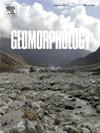地统计学方法在森林地区无人机地形研究DEM生成中的应用
IF 3.1
2区 地球科学
Q2 GEOGRAPHY, PHYSICAL
引用次数: 0
摘要
在地形研究中,尤其是在进行地形分析时,一个关键产品是数字高程模型(DEM),它通常是由无人驾驶飞行器(UAV)收集的数据生成的。然而,被高植被覆盖的地区,主要是森林,在获取航空摄影数据时是一个重要的问题,因为UAV结构-从运动(UAV- sfm)摄影测量不提供位于树冠下的地点的信息。本文旨在展示如何在基于无人机任务获取的航空摄影数据集的高植被覆盖地区生成DEM时,使用地质统计学方法对其进行改进。这项研究是在波兰中部进行的,那里形成了一个被茂密森林覆盖的抛物线形沙丘,附近发生了井喷,定期充满水。研究表明,与使用的摄影测量软件中的插值方法相比,在高植被覆盖的地形重建中使用普通克里格(OK)方法可以提供更好的结果。通过交叉验证(CV)计算得到的平均误差(ME)的低误差值:−0.0003 m,均方根误差(RMSE): 0.0777 m,克里金标准差(SDOK)的低误差值为0.002-0.44 m,证实了这一点。所得DEM与参考模型相似度为69.17 %(决定系数),相关性强(0.8316)。应用地统计学方法生成用于地形研究的DEM显示了在其他具有类似条件的地区的巨大应用潜力,为传统摄影测量方法遇到局限性的植被茂密地区提供了有效的替代方案。本文章由计算机程序翻译,如有差异,请以英文原文为准。
Application of geostatistical approach in generating DEM for relief studies using UAV in forest areas
In relief studies, and especially when performing terrain analysis, a key product is the Digital Elevation Model (DEM), which is often generated from data collected using an Unoccupied Aerial Vehicle (UAV). However, areas covered by high vegetation, mainly forests, are a significant problem when acquiring aerial photography data, since UAV Structure-from-Motion (UAV-SfM) photogrammetry does not provide information from sites located under the tree canopy. This article aims to demonstrate how to improve a DEM when generating it in areas covered with high vegetation based on an aerial photography dataset acquired by UAV missions, using geostatistical methods. The study was conducted in central Poland, where a parabolic dune covered by dense forest has formed, along with a blowout occurring in its vicinity, which is periodically filled with water. The study showed that the use of Ordinary Kriging (OK) in the reconstruction of relief covered with high vegetation provided better results compared to interpolation methods implemented in the photogrammetry software used. This is confirmed, by the computed low error values of Mean Error (ME): −0.0003 m, Root Mean Square Error (RMSE): 0.0777 m from Cross-Validation (CV) and low values of 0.002–0.44 m standard deviation of kriging (SDOK). The resulting DEM shows high similarity of 69.17 % (coefficient of determination) and a strong correlation (0.8316) with the reference model used. The applied geostatistical approach to generating the DEM for relief study demonstrates significant potential for application in other regions with similar conditions, offering an effective alternative for areas with dense vegetation where traditional photogrammetric methods encounter limitations.
求助全文
通过发布文献求助,成功后即可免费获取论文全文。
去求助
来源期刊

Geomorphology
地学-地球科学综合
CiteScore
8.00
自引率
10.30%
发文量
309
审稿时长
3.4 months
期刊介绍:
Our journal''s scope includes geomorphic themes of: tectonics and regional structure; glacial processes and landforms; fluvial sequences, Quaternary environmental change and dating; fluvial processes and landforms; mass movement, slopes and periglacial processes; hillslopes and soil erosion; weathering, karst and soils; aeolian processes and landforms, coastal dunes and arid environments; coastal and marine processes, estuaries and lakes; modelling, theoretical and quantitative geomorphology; DEM, GIS and remote sensing methods and applications; hazards, applied and planetary geomorphology; and volcanics.
 求助内容:
求助内容: 应助结果提醒方式:
应助结果提醒方式:


